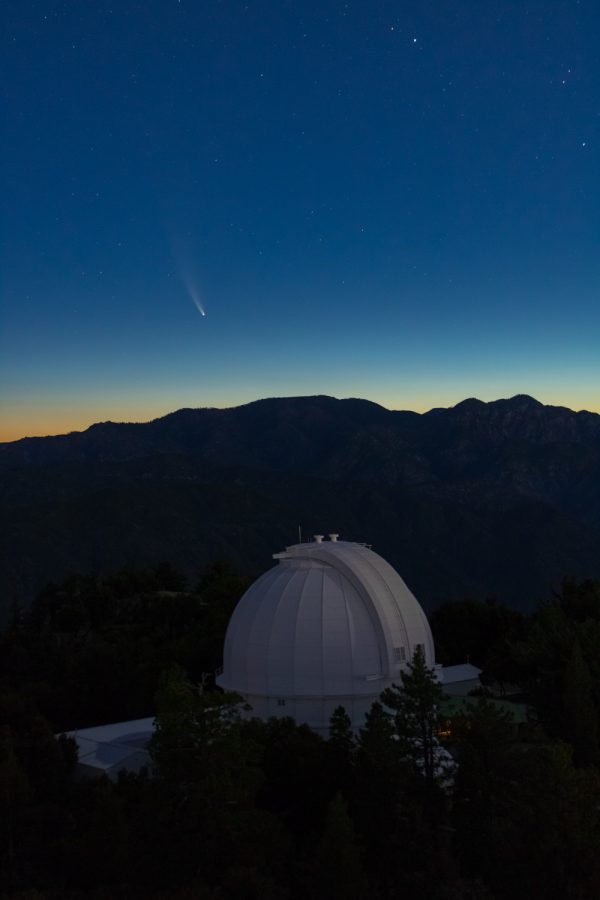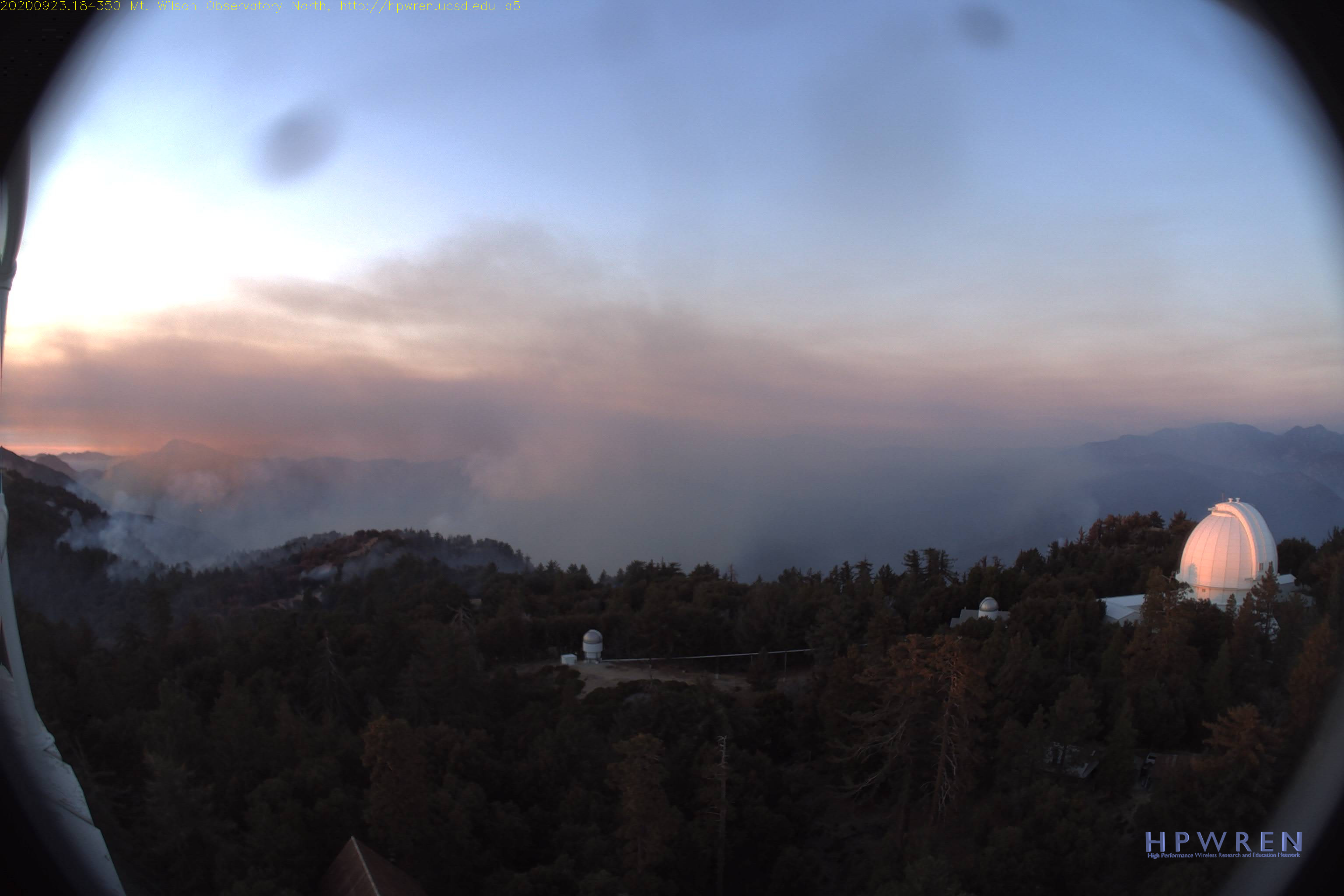Historic Mount Wilson Observatory was ready for its close call with the Bobcat Fire
The historic observatory in southern California is 116 years old.
Several months ago, the historic Mount Wilson Observatory in southern California made an extraordinary observation.
When Comet NEOWISE survived its rendezvous with the sun this summer and headed back out toward the edge of the solar system, people on Earth could see its glowing tail in the twilight hours near the horizon. And Mount Wilson Observatory's high elevation in the Angeles National Forest provided a great spot to view the brilliant, icy object.
But lately, the observatory's staff has been looking at the lights and smokey tails emitted by blazes as they weave across the nearby hills and valleys during a particularly severe fire season.
Related: Historic Mount Wilson Observatory survives close call with Southern California's Bobcat Fire

The historic 116-year-old observatory is where Edwin Hubble collected the observations that proved Andromeda is a galaxy, not a spiral nebula. Physicist Albert Michelson also used the observatory in an experiment meant to accurately measure the speed of light.
Currently the observatory is part of the Birmingham Solar Oscillations Network (BiSON) as well as home to Georgia State University's Center for High Angular Resolution Astronomy (CHARA), which can measure the diameters, distances, masses and luminosities of stars.
The observatory also studies Jupiter at about the same time that NASA's Juno spacecraft makes its closest orbital approach to the gaseous planet, Edward Rhodes, an astronomer at the University of Southern California, told Space.com. The Earthly observations are sent to NASA's Jet Propulsion Laboratory, also in California, to give the Juno team a big-picture perspective of the approach.
Get the Space.com Newsletter
Breaking space news, the latest updates on rocket launches, skywatching events and more!
"We all love this place," Thomas Meneghini, executive director of the Mount Wilson Observatory, told Space.com. "I'm an avid amateur telescope fan and amateur astronomer, and when I started [here] 20 years ago, I thought I'd fallen [to] heaven. I still do. I still operate the telescopes there, the equipment, for public outreach. And it is something I hope we can preserve for the public in the future because this [place] is inspiring. And I hope it is there to inspire the next generation of scientists."
The telescopic facilities sit across approximately 52 acres and include three solar telescopes, the CHARA array, the 60-inch and the 100-inch telescopes and a museum. For the first half of the 20th century, Mount Wilson had the biggest telescope of any observatory in the world.
For weeks, the staff has exhaustively monitored the day-to-day changes of the raging Bobcat Fire. The blaze began on Sept. 6 and in five weeks has burned across nearly 115,800 acres (470 square kilometers), or roughly the size of the city of San Jose. Meneghini expects the fire to leave an eerie landscape behind in its wake.
Climate change has exacerbated the Bobcat Fire and the dozens of fires that have raged across the western United States this year.
Earth-observing satellites have watched the smoke as it travels across the continent and even into Europe. Spacecraft continue to capture sober views of the wildfires' collective global scale. Meanwhile, a collection of cameras situated atop the observatory got an up-close look.
This isn't the observatory's first brush with wildfire, but it is one of the worst.

Meneghini told Space.com that he initially thought the Bobcat Fire would behave like a couple of milder wildfires that appeared nearby. "That turned out not to be the case … conditions changed, wind conditions picked up, it got hotter, and it started spreading in the whole area [and] it got closer to us," he said.
The steep terrain near the observatory made it difficult to fight the fire, Meneghini said. Firefighters from several agencies spent weeks battling Bobcat Fire.
The fire particularly threatened the observatory's dormitory for visiting researchers, called the Monastery. The Mount Wilson Observatory Twitter account shared video footage taken on Sept. 17, showing soot, smoke and flames billowing upward behind the building.
"How these heroic firefighters managed to save the building is incredible!" the observatory wrote. The Bobcat fire got to within 20 feet (6 meters) of the observatory, according to an Oct. 8 letter of gratitude published by Sam Hale, the chairman of the Board of Trustees of the Mount Wilson Institute that manages the observatory.
We were asked many times: "How close did the fire get?" We have the answer. (Video from SEP 17) Damage: Smoke and soot inside upper story of The Monastery but otherwise unscathed. How these heroic firefighters managed to save the building is incredible! #bobcatfire pic.twitter.com/Qt3nGbRG68September 29, 2020
Because of the area's history with blazes, there are three wells drilled into the side of the mountain used exclusively to combat fires, Meneghini said, which collect rainwater and melted ice that runs down through the rocks. Firefighters protecting the observatory could also use new fire hydrants at the facility that were added to the parking lot just a month before the Bobcat Fire arrived.
"The [U.S.] Forest Service and other fire agencies decided, from experience from the 2009 Station Fire, that they would station engines up there to fight the fire from the top,'' Meneghini told Space.com. The observatory's supervisory crew turned the keys over to the firefighters on Sept. 14, showed them how to work their system and how to turn the water pumps on, Meneghini said.
Fortunately, their containment efforts are slowly stopping the blaze. As of Oct. 5, the blaze was 88% contained, according to the County of Los Angeles Fire Department.
The area was finally sufficiently smoke-free to host firefighters from @VCFD at the 60" telescope. We're pleased that we could thank them in some small way by treating them to views of Jupiter, Saturn, Mars, the Moon and others. We plan to do this with another group tonight. pic.twitter.com/dPB4r2N152September 27, 2020
The observatory's social media accounts post regular updates on the fire. And the facility has launched a fundraiser for renovations in the wake of the close call.
Once the worst of the smoke had dissipated from the site, observatory staff thanked firefighting crews for their work in the most astronomical way possible: by showing them the night sky through the lens of the century-old 60-inch telescope, still standing thanks to their efforts.
Follow Doris Elin Urrutia on Twitter @salazar_elin. Follow us on Twitter @Spacedotcom and on Facebook.
Join our Space Forums to keep talking space on the latest missions, night sky and more! And if you have a news tip, correction or comment, let us know at: community@space.com.

Doris is a science journalist and Space.com contributor. She received a B.A. in Sociology and Communications at Fordham University in New York City. Her first work was published in collaboration with London Mining Network, where her love of science writing was born. Her passion for astronomy started as a kid when she helped her sister build a model solar system in the Bronx. She got her first shot at astronomy writing as a Space.com editorial intern and continues to write about all things cosmic for the website. Doris has also written about microscopic plant life for Scientific American’s website and about whale calls for their print magazine. She has also written about ancient humans for Inverse, with stories ranging from how to recreate Pompeii’s cuisine to how to map the Polynesian expansion through genomics. She currently shares her home with two rabbits. Follow her on twitter at @salazar_elin.
-
Helio I think there was another California observatory that was spared in the lick of time from another fire.Reply









